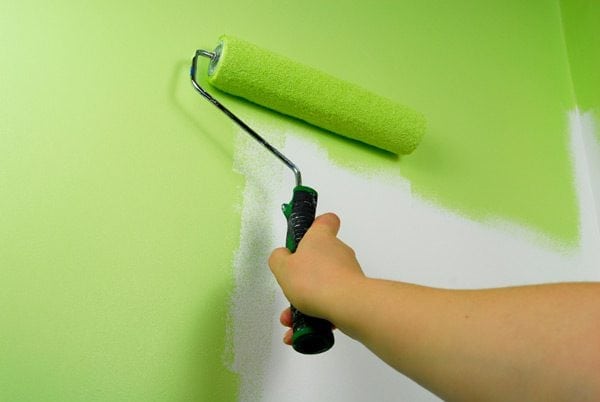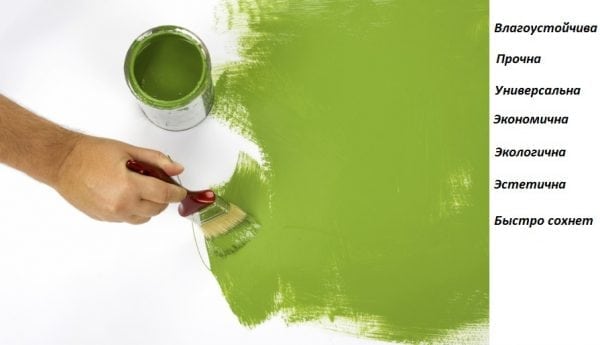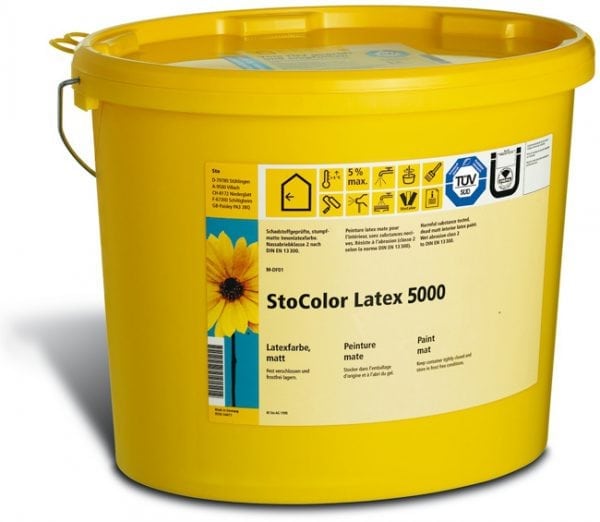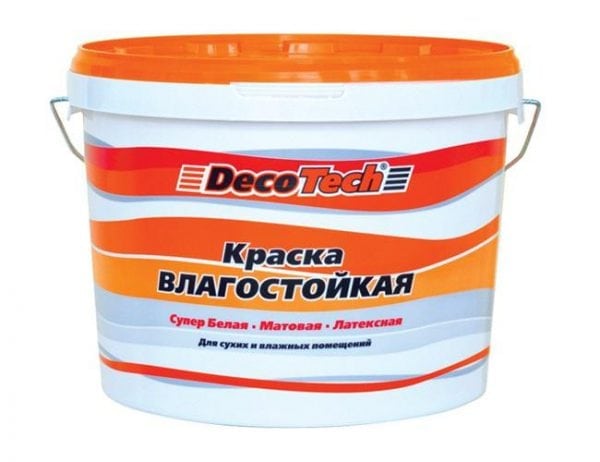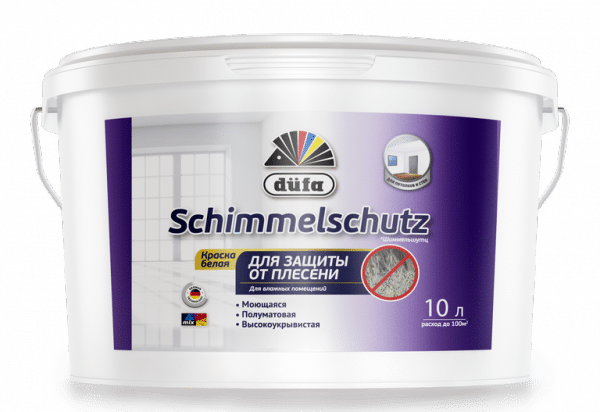Latex paint for walls began to be used not very long ago. But professional craftsmen have already appreciated its advantages and disadvantages. But among craftsmen who prefer to do facade and interior work with their own hands, there is no consensus. What is this dye? Is it worth it to use, or is it better to give preference to known paints and varnishes?
- Pros and cons
- How to choose a latex based product
- Gloss degree
- Moisture resistance and wear resistance
- Hiding power
- Availability of additives
- How to paint
- Features of painted surface care
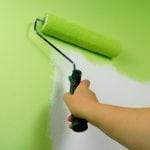
Pros and cons
Latex paint refers to water-based dyes, but with the addition of synthetic rubber polymer (latex). Like all paints and varnishes, this dye has its pros and cons, which determine the scope of its use. The benefits include:
- Moisture resistant. With this composition, you can paint the walls in any room, even with high humidity (bath, kitchen or bath).
- Strength. After drying, a thin, strong, easily washable film forms, and the walls can be washed without harm to the coating, even using household chemicals. But you can only wash it with a damp sponge - from frequent contact with water, the latex coating can be damaged.
- Universality. Latex polymer provides high-quality adhesion to any surface (concrete, wood, paper). The interior decoration with this paint will look spectacular on any basis.
- Thermal insulation. The latex base gives the walls additional thermal insulation qualities.
- Profitability. Paint is distributed on the surface of the walls in a thin layer.
- Environmental friendliness. The coloring agent does not contain toxic substances, it can be used for interior decoration of the walls of living rooms and kitchens. In addition, latex formulations, like their water-dispersed “brothers,” have a breathable structure, providing a healthy indoor climate.
- Aesthetics. A thin layer does not hide, but emphasizes the surface structure. In addition, a beautiful matte finish (mixtures with varying degrees of dullness are produced) brings a highlight to the interior design of the premises.
- Quick drying. From the time of application to complete drying takes about 20 minutes.
- Strength. With proper use, the paint stays on the walls for a long time.
But there are dye based on latex and cons:
- Inability to hide defects on the surface of the walls. A thin layer formed after the coloring agent dries completely repeats the surface texture. If the walls are uneven, then before painting it is necessary to level the base.
- Instability to subzero temperatures. The coloring composition is suitable only for interior decoration, and it is not practical to use it for facade decoration. In addition, it is not recommended to paint them with the internal walls of the premises, if there is a possibility that temperature differences will occur.For example, if it is not known for sure whether a winter residence in a country house will be permanent, it is better to prefer other materials for the decoration of the walls of the rooms.
- There is a chance of developing fungus or mold on the walls. If latex paint is used for a bathroom, kitchen or other damp rooms, it is necessary to take care of good ventilation. In addition, during preparation for painting the walls, it is recommended to additionally treat with special preparations from fungus and mold.
- High price. This is a doubtful drawback, because the life of the coloring agent is large and the subsequent decoration of rooms will not be needed soon.
How to choose a latex based product
Deciding what is needed good washable paint for the interior decoration of wet rooms or rooms where the walls are often dirty, for example, for the kitchen, it is not enough to choose only the color shades of the composition. Given that the repairs made will last a long time, you need to carefully choose a washable dye for interior decoration. When choosing, it is necessary to consider various parameters.
Gloss degree
Most often, matte gloss is used to decorate rooms. But in the line of this product there are compounds that have a high degree of gloss and are able to give the walls an almost mirror-like, reflective effect.
to contents ↑High degrees of gloss are rarely used for interior work in living rooms: such a coloring is tiring with its brilliance. But very often, designers use such shine in a small amount to give a twist to the design of the room.
Moisture resistance and wear resistance
For latex-based products, abrasion resistance, despite the fact that the paint is washable, is determined by resistance to moisture. On the packaging for the product before purchase, you must see the class of resistance to abrasion. The highest will be the first class, designed for wet rooms, such as a kitchen or bathroom, where the temperature is always slightly elevated and the walls can often get dirty. This is especially important for the kitchen, because there the walls are exposed not only to the influence of a moist, warm atmosphere, but they also have an additional mechanical effect due to constantly occurring contaminants.
Hiding power
Determines how evenly, without sagging and bald spots, the material is distributed over the painted surface. As a rule, all latex dyes have a high degree of hiding power.
Availability of additives
As with conventional water dispersible preparations, latex-based colorants can be added to protect against mold, rot or fungus. For work in humid rooms (sauna, kitchen or bathroom), it is advisable to purchase such funds.
How to paint
The staining process for latex formulations is exactly the same as for water dispersion formulations. First you need to prepare the surface of the walls. For this purpose, do the following procedures:
- Cleaning up. The wall is cleaned of dust, dirt and the remnants of the old decorative coating. Washable bases are thoroughly washed and dried, non-washable (wallpaper or other materials with a paper base) can be cleaned of dust particles with a vacuum cleaner.
- Impregnation. In humid rooms, if the dye does not have special additives, the walls are pre-treated with an anti-mildew impregnation.
- Alignment. This step is used if the walls are uneven. To do this, it is better to use decorative plaster. If this is neglected, then after painting the entire deformed surface structure will be visible.
- Padding. Despite the fact that latex-based dyes have high adhesion, it is recommended to prime the surfaces before painting during interior work.Conducting priming work will take a little time, in addition, primers are inexpensive, but this measure will significantly increase the durability of the repair.
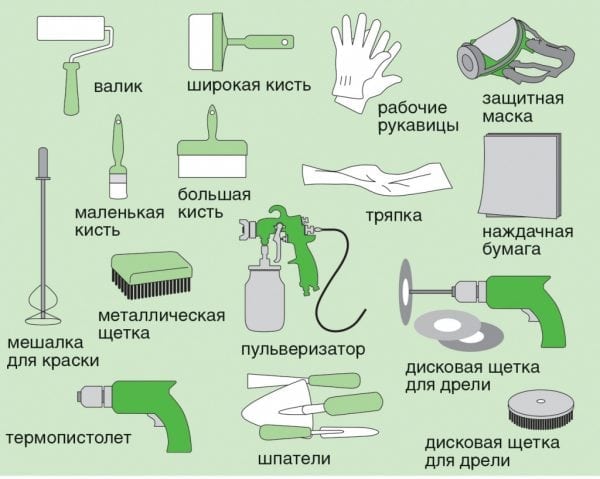
After the soil has dried, it is possible to paint (painting a wet base is not recommended - this will affect the quality of the repair). In order to paint, you can use:
- spray gun;
- rollers of various sizes;
- brushes.
After applying the first layer, you need to let it dry well (at a temperature in the room of 20 degrees and normal ventilation, the drying process takes about 20 minutes), and then apply another layer again. As a rule, two layers are enough for interior work.
to contents ↑After an hour, the film covering the surface finally polymerizes and becomes strong.
Features of painted surface care
So that the interior design lasts a long time, professional masters advise:
- In the first month, use only a soft brush or sponge to care for painted walls, and from detergents, give preference to those that do not contain active chemical elements (use only neutral or slightly alkaline solutions).
- Despite the fact that the washable surface is quite durable, it is undesirable to use hard washcloths or brushes during cleaning - this will lead to premature abrasion, and can also violate the glossiness of the base.
If latex-based formulations are used, taking into account their physicochemical characteristics, long-term aesthetic repairs can be ensured.

